Analyse de la carte : Incubateur d'Urza
Rubrique Analyses
Informations
Date : 01/02/2006 à 00:00
Auteur : Nhoun
Lecture : 10240
Nombre de commentaire : 13
Fiche du Membre
Hors Ligne
![]() Membre Inactif depuis le 25/11/2009
Membre Inactif depuis le 25/11/2009
Grade : [Druide] ![]()
Inscrit le 09/06/2004
2 Messages/ 0 Contributions/ 35 Pts

Texte Anglais
Urza's Incubator 
Artifact
As Urza's Incubator enters the battlefield, choose a creature type.
Creature spells of the chosen type cost 2 less to cast.

Artifact
As Urza's Incubator enters the battlefield, choose a creature type.
Creature spells of the chosen type cost 2 less to cast.
Texte Français
Incubateur d'Urza 
Artefact
Au moment où l'Incubateur d'Urza arrive sur le champ de bataille, choisissez un type de créature.
Les sorts de créature du type choisi coûtent 2 de moins à lancer.

Artefact
Au moment où l'Incubateur d'Urza arrive sur le champ de bataille, choisissez un type de créature.
Les sorts de créature du type choisi coûtent 2 de moins à lancer.
Infos sur cette Carte Magic
Disponibilités :
Explication de l'analyse de la carte par l'auteur
Bonjour à tous. Aujourd'hui je vais analyser une carte que du nom d'incubateur d'urza. Voyons tout de suite le sommaire de l'analyse:
Sommaire
Technique
1- Couleur, Coût, type
2- Capacité
3- Jouer avec
4- Jouer contre
5- Deck
6- Cartes ressemblantes
7- Avantages/Inconvénients
8- FAQ
9- Conclusion
Extra
1- Edition
2- Illustration/Illustrateur
3- Storyline
4- Texte d'ambiance
5- Le mot de la fin
1- Couleur, Coût, type
Le coût de l'incubateur est de . Ceci est du mana incolore. ça voudra dire qu'on pourra payer ce coût d'invocation avec n'importe quelle couleur de mana qu'il existe à Magic. C'est très pratique et pour cause, on peut intégrer cette carte à beaucoup de jeux magic, ce qui en fait sa puissance. De plus, on remarque que le coût en mana de la carte est assez faible, ce qui nous permettra de la sortir assez rapidement. Chose utile d'ailleurs pour sa capacité que l'on évoquera un peu plus tard dans l'analyse.
Le coût de mana, (ou plutôt la couleur du mana de la carte) définie la couleur de cette dernière. Ici, le mana est incolore. Carte sans couleur : ça sera donc un artefact En voici des exemples:
. Ceci est du mana incolore. ça voudra dire qu'on pourra payer ce coût d'invocation avec n'importe quelle couleur de mana qu'il existe à Magic. C'est très pratique et pour cause, on peut intégrer cette carte à beaucoup de jeux magic, ce qui en fait sa puissance. De plus, on remarque que le coût en mana de la carte est assez faible, ce qui nous permettra de la sortir assez rapidement. Chose utile d'ailleurs pour sa capacité que l'on évoquera un peu plus tard dans l'analyse.
Le coût de mana, (ou plutôt la couleur du mana de la carte) définie la couleur de cette dernière. Ici, le mana est incolore. Carte sans couleur : ça sera donc un artefact En voici des exemples:
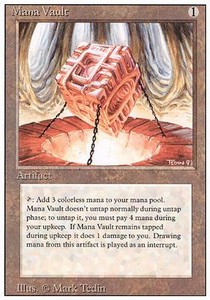
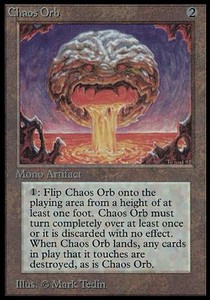
2- Capacité
Nous voilà déjà à la capacité de la carte. Alors voyons tout d'abord ce que dit l'ensemble du texte de la carte:
 de moins à jouer, aussi bien pour ceux que je jouerai que ceux que l'adversaire invoquera. C'est bien ou c'est pas bien? Disons que c'est moyen. Eh oui, si j'ai un esprit qui coûte
de moins à jouer, aussi bien pour ceux que je jouerai que ceux que l'adversaire invoquera. C'est bien ou c'est pas bien? Disons que c'est moyen. Eh oui, si j'ai un esprit qui coûte à jouer, je ne pourrai pas bénéficier de la "réduction" du coût de mana puisque sur le texte de l'incubateur est bien marqué "
à jouer, je ne pourrai pas bénéficier de la "réduction" du coût de mana puisque sur le texte de l'incubateur est bien marqué " de moins à jouer " et ceci n'est pas une réduction de mana coloré. Donc ça sert à rien dans cette situation. En revanche, c'est bien utile pour les grosses cartes en général. On peut en citer quelques unes:
de moins à jouer " et ceci n'est pas une réduction de mana coloré. Donc ça sert à rien dans cette situation. En revanche, c'est bien utile pour les grosses cartes en général. On peut en citer quelques unes:
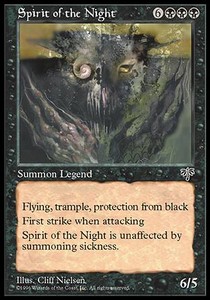
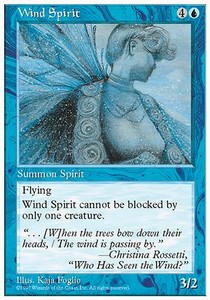
3- Jouer avec
C'est vraiment le genre de carte qui se joue dans un deck relativement lent à la base pour ainsi le booster et pour pouvoir mieux sortir les gros thons. L'incubateur d'Urza est, à mon avis rentabilisé au ma ximum dans un jeu utilisant beaucoup de créatures du même type. Ex: rats, esprits, soratami, zombi, clerc, gobelin, elfe etc...
4- Jouer contre
En blanc
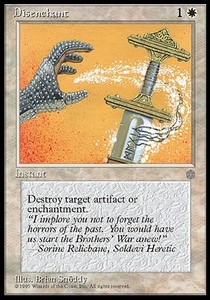
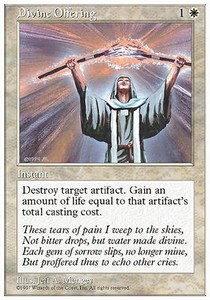
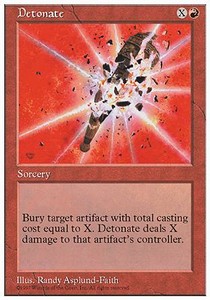
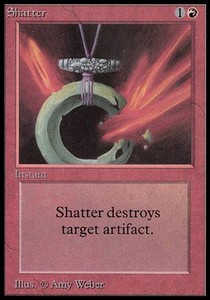
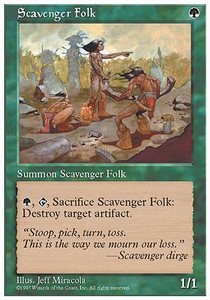
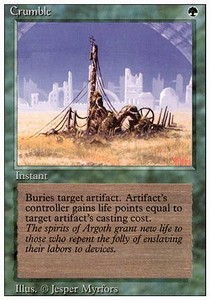
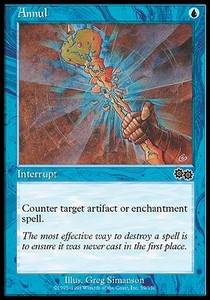
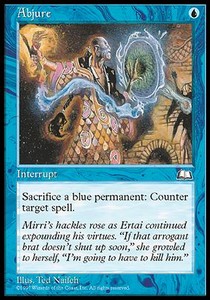
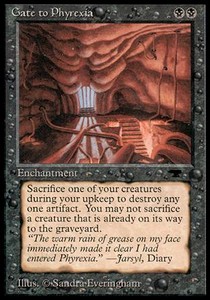
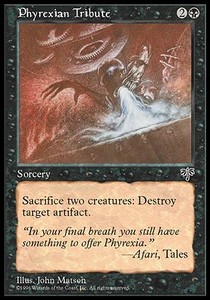
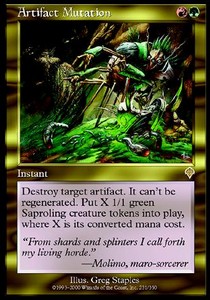
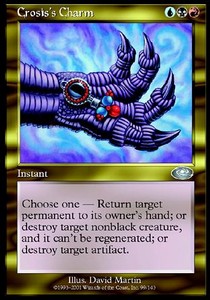
5- Deck
Créatures :
4 Ange Exalté
4 Lions des savanes
4 Radieuse, Archange
4 Aumônier bien-aimé
2 Chasseciel léonin
2 Voix du Grand Tout
Sorts :
3 Armageddon
2 Antienne glorieuse
1 Colère de Dieu
2 Incubateur d'Urza
4 Echardes d'Ailes
4 Souffle de vie
2 Arrestation
2 Jour saint
Terrains :
1 Havre kor
19 Plaine
--------------------------------------------------------------------------------
Réserve :
3 Adoration
4 Chevalier sacré mystique
2 Purification
2 Sacrement divin
2 Arrestation
2 Désenchantement
Explication du deck
Ce deck a pour kill les nombreux anges. En effet, ils sont assez difficiles à poser, c'est pourquoi l'incubateur d'Urza figure dans ce deck. Les débuts de parties seront amorcés par des cartes telles que Lions des savanes, ou bien Chasseciel léonin. Ensuite, armaggedon et colère de dieu seront nécessaires. Ensuite, les gros thons arrivent, tels que ange exalté et finissent l'adversaire...
6- Cartes ressemblantes
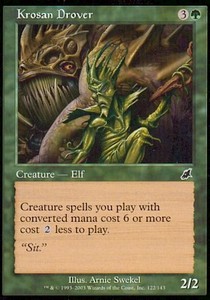
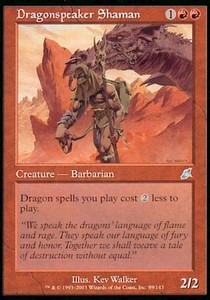
7- Avantages/Inconvénients
Avantages: 
 - Accélère les jeux lents de nature
- Accélère les jeux lents de nature
 - Arrive assez vite en jeu
- Arrive assez vite en jeu
 - C'est un artefact donc utiliseable dans des decks colorés
Inconvénients:
- C'est un artefact donc utiliseable dans des decks colorés
Inconvénients: 
 - Réduit de deux manas incolores
- Réduit de deux manas incolores
 - S'applique aussi à l'adversaire
- S'applique aussi à l'adversaire
 - Très vulnérable aux sorts de destruction
- Très vulnérable aux sorts de destruction
9- FAQ
Question  Réponse
Réponse 
 Mon adversaire a posé un incubateur d'urza en jeu en nommant les créatures du type Elfe. Est-ce que je peux poser un elfe provocateur gratuitement?
Mon adversaire a posé un incubateur d'urza en jeu en nommant les créatures du type Elfe. Est-ce que je peux poser un elfe provocateur gratuitement?
 Non. Dans le texte de l'incubateur d'urza c'est marqué que les sorts de créature du type choisi (ici elfe) coutent 2 manas incolores de moins. Or le coût converti de mana de l'elfe provocateur est d'un mana vert. Il faudra donc payer un mana vert pour pouvoir le jouer et la capacité de l'incubateur ne serviera donc à rien.
Non. Dans le texte de l'incubateur d'urza c'est marqué que les sorts de créature du type choisi (ici elfe) coutent 2 manas incolores de moins. Or le coût converti de mana de l'elfe provocateur est d'un mana vert. Il faudra donc payer un mana vert pour pouvoir le jouer et la capacité de l'incubateur ne serviera donc à rien.
 Est-ce que, si je n'utilise pas la capacité de l'incubateur, dans la même situation que précédemment je me prends des brûlures de mana?
Est-ce que, si je n'utilise pas la capacité de l'incubateur, dans la même situation que précédemment je me prends des brûlures de mana?
 Non, car la capacité de l'incubateur ne dit pas "ajoutez
Non, car la capacité de l'incubateur ne dit pas "ajoutez à votre réserve" auquel cas ça ferait deux brûlures de mana en fin de tour. Ici, c'est "réduit" qui apparait dans le texte de l'incubateur ce qui ne provoquera aucune conséquences si l'on utilise pas la capacité de ce dernier.
à votre réserve" auquel cas ça ferait deux brûlures de mana en fin de tour. Ici, c'est "réduit" qui apparait dans le texte de l'incubateur ce qui ne provoquera aucune conséquences si l'on utilise pas la capacité de ce dernier.
 Je joue une Guivre Autochtone ayant déjà sous mon contrôle un incubateur d'urza avec comme sous type choisi: guivre. Est-ce que je peux combiner la convocation avec la capacité de l'artefact?
Je joue une Guivre Autochtone ayant déjà sous mon contrôle un incubateur d'urza avec comme sous type choisi: guivre. Est-ce que je peux combiner la convocation avec la capacité de l'artefact?
 Absolument. Imagines que tu as deux créatures déjà en jeu. Tu engages tes deux créatures pour réduire le coût de la guivre de 2 manas (incolores ou de la couleur des créatures engagées) et puis tu as également la capacité de l'incubateur qui te réduiera de 2 manas incolores.
Absolument. Imagines que tu as deux créatures déjà en jeu. Tu engages tes deux créatures pour réduire le coût de la guivre de 2 manas (incolores ou de la couleur des créatures engagées) et puis tu as également la capacité de l'incubateur qui te réduiera de 2 manas incolores.
 Si j'ai un incubateur d'urza en jeu ainsi que mon adversaire, que se passe-t-il?
Si j'ai un incubateur d'urza en jeu ainsi que mon adversaire, que se passe-t-il?
 Bah les deux capacités se cumuleront, du coup ce n'est pas de
Bah les deux capacités se cumuleront, du coup ce n'est pas de mais de
mais de manas incolores que le coût de la carte en question sera réduit.
manas incolores que le coût de la carte en question sera réduit.
9- Conclusion
C'est donc une carte assez sympa à jouer dans l'ensemble mais qui présente cependant des inconvénients non néglieables qu'il faudra prendre en compte lors de l'utilisation de cette carte. Et bien voilà, j'en ai terminé avec l'analyse technique. Rendez vous dès maintenant pour l'analyse extra de la carte.1- Edition

 Commune
Commune
 Unco
Unco
 Rare
Rare

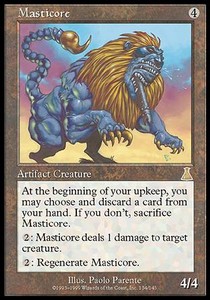
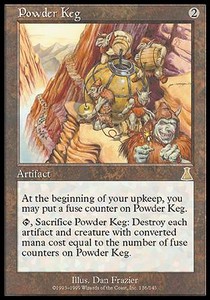
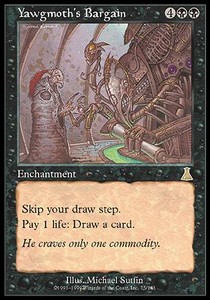 La destinée d'Urza est la 3ème extension du bloc Urza. Elle laisse se développer les jeux combos, vu le nombre de cartes que contient cette extension et pouvant s'intégrer dans ce type de jeu (marché selon yaugzebul, donation, opalescence, réassortiment…) Malgré cela l'extension ne semble pas avoir convaincu de nombreux joueurs. Deux nouveaux concepts apparaissent, ce sont les sorts du type ''rigoureux'' qui retirent de la partie toutes les copies d'une même carte qui se trouvent dans la bibliothèque, le cimetière et la main de son propriétaire. Le second concept est un type de sort qui est plus ou moins puissant suivant le nombre de cartes d'une couleur donnée que vous révélez de votre main.
La destinée d'Urza est la 3ème extension du bloc Urza. Elle laisse se développer les jeux combos, vu le nombre de cartes que contient cette extension et pouvant s'intégrer dans ce type de jeu (marché selon yaugzebul, donation, opalescence, réassortiment…) Malgré cela l'extension ne semble pas avoir convaincu de nombreux joueurs. Deux nouveaux concepts apparaissent, ce sont les sorts du type ''rigoureux'' qui retirent de la partie toutes les copies d'une même carte qui se trouvent dans la bibliothèque, le cimetière et la main de son propriétaire. Le second concept est un type de sort qui est plus ou moins puissant suivant le nombre de cartes d'une couleur donnée que vous révélez de votre main.
2- Illustration/Illustrateur
L'illustration de la carte représente un homme avec un livre dans la main gauche et la main droite au dessus d'un miroir. Dans celui-ci reflète une créature bleue. On peut très bien imaginer que le reflet du miroir correspond au choix du sous type fait par l'homme en question.
L'illustrateur de la carte est Pete Venters. C'est une personne qui a illustré pas mal de cartes magic. En voici quelques unes:
Lance-roquettes, Flétrissement, Lavage de cerveau, Cercle de protection :artefact, Érosion, Force de la Nature, Arène phyrexiane, Héros gobelin, Guerrier homaride, Lhurgoyf, Pillards gobelins de Mons, Paladin de Serra, Héros gobelin, Résolution héroïque, Minotaure talruúm, Vitalité, Contrainte, Pacte avec les enfers, Étoile de fer, Maro, Raid nocturne, Griffon serres-rasoir, Jour saint,Invisibilité, Lhurgoyf, Affinité naturelle, Tremblement, Montagnard gobelin, Jour saint, Nouvelles, Démon de Yaugzebul, Flétrissement, Hellfire, The Abyss, Touch of Darkness, Wall of Shadows, Gaea's Avenger, Mightstone, Orcish Mechanics, Lance-roquettes, Sage de Lat-Nam, Cleansing, Érosion, Icatian Lieutenant, Thelon's Curse, Créophage, Kavru languefeu, Maraudeur skirkien,Distorsion temporelle, Chants des damnés, Butin de guerre, Esprit tempête, Mur de lave, Coeur de la Yavimaya, Lac de la mort, Augure ardent, Portail vers Phyrexia, Décret royal, Mage itinérante, Baron sengir, Château Sengir, Grand-mère Sengir, Irini Sengir, Paladin de Serra, Destin posthume, Cuirassé phyrexian, Cercle prismatique, Minotaure talruúm, Vigilants nains, Escouflenfer soufflefeu, Nécromancie, Argousin ogre, Champion talruúm, Joueur de fifre talruúm, Missionnaire bénalian, Dette de loyauté, Gambit désespéré, Druide de Llanowar, Colons orques, Cavalier de l'ombre, Vitalité, Charognette, Coercition, Force de géant, Résolution héroïque, Conscrits moggs, Rancune téméraire, Jubilation sadique, Distorsion temporelle, Crorax le maudit, Piègepont,Hésitation, Plans d'invasion, Lanciers en-Kor, Infestation de moggs, Tamis, Créophage, Rage démente, Pandémonium, Tuerie, Survie du plus apte, Crasse, Carnappeur, Pour le plus grand bien, Oppression, Peste, Goule phyrexiane, Aubaine, Archiviste, Inversion bénie, Désastre imminent, Grognardes de Radieuse etc etc.....
Les cartes apparaissant en gras étant les plus connues.J'espère que vous vous êtes fait plaisir  Bon, Voilà à présent un morceau de l'expérience de cet illustrateur que vous connaissez tous j'espère, puisque c'est l'un de ceux qui a illustré le plus de cartes magic (plus de 250):
Pete Venters is into his 11th year of painting Magic cards; he started with Antiquities and has managed to contribute to every set since (except Three Kingdoms). Pete counts himself very lucky to currently have created the most artwork in Magic by a single artist—211 pieces with the release of Fifth Dawn (213 if you include Vanguard)! Some of Pete's best known pieces include The Abyss, Baron Sengir, Phyrexian Dreadnought, Lake of the Dead, Lhurgoyf, Flametongue Kavu and Phyrexian Arena. Recent additions that Pete's especially proud of include Tanglewalker, Raksha Golden Cub and the truly vile-looking Desecration Elemental.
Pete is a regular poster in the Art & Artist Forums on Wizards' own Magic: The Gathering Boards. Occasionally he posts sets of sketches to show the development of some cards from initial idea to final painting. Currently, Pete is working on the Kamigawa Block but what he's really looking forward to is the release of Unhinged which includes, in his words, "One of the most excessive, over-the-top images I've ever done for Magic."
source: wizards of the coast.
voici sa photo:
Bon, Voilà à présent un morceau de l'expérience de cet illustrateur que vous connaissez tous j'espère, puisque c'est l'un de ceux qui a illustré le plus de cartes magic (plus de 250):
Pete Venters is into his 11th year of painting Magic cards; he started with Antiquities and has managed to contribute to every set since (except Three Kingdoms). Pete counts himself very lucky to currently have created the most artwork in Magic by a single artist—211 pieces with the release of Fifth Dawn (213 if you include Vanguard)! Some of Pete's best known pieces include The Abyss, Baron Sengir, Phyrexian Dreadnought, Lake of the Dead, Lhurgoyf, Flametongue Kavu and Phyrexian Arena. Recent additions that Pete's especially proud of include Tanglewalker, Raksha Golden Cub and the truly vile-looking Desecration Elemental.
Pete is a regular poster in the Art & Artist Forums on Wizards' own Magic: The Gathering Boards. Occasionally he posts sets of sketches to show the development of some cards from initial idea to final painting. Currently, Pete is working on the Kamigawa Block but what he's really looking forward to is the release of Unhinged which includes, in his words, "One of the most excessive, over-the-top images I've ever done for Magic."
source: wizards of the coast.
voici sa photo:

 cuirassé phyrexian
cuirassé phyrexian

 détournement de sort
détournement de sort
3- Storyline
Bon, et bien voilà la storyline en anglais sorry pour ceux qui ne parlent pas anglais mais bon, je me suis dit qu'il valait mieux un bon texte anglais qu'un texte mal traduit (par les traducteurs sur internet). Et puis là j'ai pas trop le courage de traduire tout ça  The Brothers' War between Mishra and Urza, the two most powerful artificers on Dominaria, is coming to a head in the Argoth forest. Discovered accidentally by the pilot of a lost ornithopter, Argoth's rich natural resources soon prove irresistible to the brothers. Each attempts to claim those resources for himself to fuel his war efforts-and to keep the other from obtaining them.
The struggle for Argoth involves not only the brothers but also the sentient forest itself, with terrible consequences: Urza is pushed to the limits of his sanity, Mishra into the waiting arms of Phyrexia, and Argoth toward utter extinction as the three-way war drags on. In the apocalyptic final battle, Urza personally vies with Mishra and reveals him to be a construct of flesh and Phyrexian metal. When Mishra completely abandons his humanity to attack his brother, Urza releases an enormous burst of power that destroys both Mishra and a huge portion of the forest they were fighting over. At the heart of the maelstrom of energy he has created, Urza transcends his mortal origins and takes his place as a planeswalker, the most powerful kind of spellcaster, with the ability to travel between the planes of the multiverse.
Unbalanced by both his transformation and the catastrophic events in Argoth, Urza fixates on the beings responsible for his brother's physical and spiritual corruption: the Phyrexians. He uses his newfound ability to traverse the planes seeking out his enemies but is unable to find their home plane until he rescues Xantcha, a Phyrexian construct about to be executed by her kin for failing to realize her full potential. With Xantcha as his guide, Urza is finally able to planeswalk to Phyrexia; almost immediately, however, he finds that he has underestimated both his enemy and the terrain of the battle. Phyrexia is a noxious, corrosive place, and the formidable horrors that live there attack Urza upon his arrival. Assaulted by the poisonous atmosphere and hard-pressed to defend himself, Urza is forced to make a hasty withdrawal. Before they leave, though, Xantcha reclaims her personality matrix (held in a magical mechanism called her "heart") from her former masters. Wounded and ailing, Urza blindly flees from Phyrexia with Xantcha in tow, his mission a failure and the advantage of surprise squandered.
Urza's flight from Phyrexia lands him in the company of another planeswalker-Serra. She has sequestered herself in her own private plane devoted to healing, order, and purity. Urza and Xantcha are granted Serra's hospitality and spend five years recovering from their Phyrexian ordeal. Once he is restored, Urza recognizes some structural similarities between Phyrexia and Serra's realm that do not bode well for either plane. Artificial planes such as these, he discovers, eventually degrade and collapse. This fact explains the Phyrexians' aggression: their own plane will someday cease to exist, and they must find another, more stable place to live. Urza is alarmed at the realization that Dominaria is the Phyrexians' target and quickly returns home with Xantcha. Soon after, a Phyrexian assault force arrives in Serra's realm, having tracked Urza there. There is a short and devastating battle between the Phyrexians and Serra's defenders until the former realize their prey has escaped them. They abandon the fight and quit the plane, but not before inflicting heavy casualties, seizing prisoners, and forever spoiling the realm's pristine wonder.
Unaware of the damage done in his wake, Urza returns to Dominaria and attempts to organize resistance to the Phyrexian invasion. He has physically healed in Serra's realm, but is still mentally unbalanced from his experiences. Xantcha forces a confrontation and resolution so that Urza can bring his full faculties to bear on planning the resistance: she repeatedly exposes him to a young man who is virtually identical to Mishra. She succeeds in calming Urza's troubled mind, but they are soon attacked again-this time by the Yawgmoth praetor Gix. This attack kills Xantcha and the Mishra double, as well as Gix himself. Urza is able to recover Xantcha's heart and puts it away until he can find the proper use for it.
Urza becomes convinced that the Phyrexians attempted to invade once before and were driven off by an advanced but extinct race called the Thran. With a new clarity of purpose, he decides to travel back in time to meet the Thran and learn their secrets. Toward this end, he establishes a wizards' academy on the remote island of Tolaria and staffs it with the best and brightest mages he can find, all the while taking extraordinary steps to avoid infiltration by Phyrexian spies. As the mysterious patron of the academy, Urza personally verifies each applicant's identity and issues an island-wide ban on adult visitors. He guides all manner of time-travel experiments, and constructs a mechanical being who becomes his primary tool for gathering data. He incorporates Xantcha's personality matrix into this sentient silver golem, named Karn, so that it will learn and mature. The experimental time portal requires an awesome amount of power, yet the golem reports that he is able to go back in time a maximum of only two days. Urza presses on, however, feeding more and more power into his time portal until inevitably, it overloads and explodes, flooding the entire island with temporal distortions. Barely half the academy's population survives, and Urza is forced to abandon this approach to defeating the Phyrexians. In time the academy is rebuilt and continues to teach and train, but Urza departs Tolaria immediately after the disaster to search for more present-day information on the Thran.
In the volcanic land of Shiv, Urza discovers the mana rig, a huge installation full of functional Thran technology. After earning the respect of the saurian viashino who live in the installation, Urza explores the equipment and determines its purpose: to create huge crystal batteries of energy, called powerstones, that can be used to run all manner of artifact devices. Although he and the viashino cannot operate all the necessary machines on their own, Urza begins to see the advantages of this energy source. He envisions a conglomeration of artifice, organic components, and pure magic that, when powered by such a stone, could be used together to halt the coming invasion in one fell swoop.
Constructing such a complicated weapon will take decades, perhaps centuries; Urza begins to make the necessary preparations for designing, transporting, and storing each part of his new Legacy until he is ready to use it to save Dominaria.
The Brothers' War between Mishra and Urza, the two most powerful artificers on Dominaria, is coming to a head in the Argoth forest. Discovered accidentally by the pilot of a lost ornithopter, Argoth's rich natural resources soon prove irresistible to the brothers. Each attempts to claim those resources for himself to fuel his war efforts-and to keep the other from obtaining them.
The struggle for Argoth involves not only the brothers but also the sentient forest itself, with terrible consequences: Urza is pushed to the limits of his sanity, Mishra into the waiting arms of Phyrexia, and Argoth toward utter extinction as the three-way war drags on. In the apocalyptic final battle, Urza personally vies with Mishra and reveals him to be a construct of flesh and Phyrexian metal. When Mishra completely abandons his humanity to attack his brother, Urza releases an enormous burst of power that destroys both Mishra and a huge portion of the forest they were fighting over. At the heart of the maelstrom of energy he has created, Urza transcends his mortal origins and takes his place as a planeswalker, the most powerful kind of spellcaster, with the ability to travel between the planes of the multiverse.
Unbalanced by both his transformation and the catastrophic events in Argoth, Urza fixates on the beings responsible for his brother's physical and spiritual corruption: the Phyrexians. He uses his newfound ability to traverse the planes seeking out his enemies but is unable to find their home plane until he rescues Xantcha, a Phyrexian construct about to be executed by her kin for failing to realize her full potential. With Xantcha as his guide, Urza is finally able to planeswalk to Phyrexia; almost immediately, however, he finds that he has underestimated both his enemy and the terrain of the battle. Phyrexia is a noxious, corrosive place, and the formidable horrors that live there attack Urza upon his arrival. Assaulted by the poisonous atmosphere and hard-pressed to defend himself, Urza is forced to make a hasty withdrawal. Before they leave, though, Xantcha reclaims her personality matrix (held in a magical mechanism called her "heart") from her former masters. Wounded and ailing, Urza blindly flees from Phyrexia with Xantcha in tow, his mission a failure and the advantage of surprise squandered.
Urza's flight from Phyrexia lands him in the company of another planeswalker-Serra. She has sequestered herself in her own private plane devoted to healing, order, and purity. Urza and Xantcha are granted Serra's hospitality and spend five years recovering from their Phyrexian ordeal. Once he is restored, Urza recognizes some structural similarities between Phyrexia and Serra's realm that do not bode well for either plane. Artificial planes such as these, he discovers, eventually degrade and collapse. This fact explains the Phyrexians' aggression: their own plane will someday cease to exist, and they must find another, more stable place to live. Urza is alarmed at the realization that Dominaria is the Phyrexians' target and quickly returns home with Xantcha. Soon after, a Phyrexian assault force arrives in Serra's realm, having tracked Urza there. There is a short and devastating battle between the Phyrexians and Serra's defenders until the former realize their prey has escaped them. They abandon the fight and quit the plane, but not before inflicting heavy casualties, seizing prisoners, and forever spoiling the realm's pristine wonder.
Unaware of the damage done in his wake, Urza returns to Dominaria and attempts to organize resistance to the Phyrexian invasion. He has physically healed in Serra's realm, but is still mentally unbalanced from his experiences. Xantcha forces a confrontation and resolution so that Urza can bring his full faculties to bear on planning the resistance: she repeatedly exposes him to a young man who is virtually identical to Mishra. She succeeds in calming Urza's troubled mind, but they are soon attacked again-this time by the Yawgmoth praetor Gix. This attack kills Xantcha and the Mishra double, as well as Gix himself. Urza is able to recover Xantcha's heart and puts it away until he can find the proper use for it.
Urza becomes convinced that the Phyrexians attempted to invade once before and were driven off by an advanced but extinct race called the Thran. With a new clarity of purpose, he decides to travel back in time to meet the Thran and learn their secrets. Toward this end, he establishes a wizards' academy on the remote island of Tolaria and staffs it with the best and brightest mages he can find, all the while taking extraordinary steps to avoid infiltration by Phyrexian spies. As the mysterious patron of the academy, Urza personally verifies each applicant's identity and issues an island-wide ban on adult visitors. He guides all manner of time-travel experiments, and constructs a mechanical being who becomes his primary tool for gathering data. He incorporates Xantcha's personality matrix into this sentient silver golem, named Karn, so that it will learn and mature. The experimental time portal requires an awesome amount of power, yet the golem reports that he is able to go back in time a maximum of only two days. Urza presses on, however, feeding more and more power into his time portal until inevitably, it overloads and explodes, flooding the entire island with temporal distortions. Barely half the academy's population survives, and Urza is forced to abandon this approach to defeating the Phyrexians. In time the academy is rebuilt and continues to teach and train, but Urza departs Tolaria immediately after the disaster to search for more present-day information on the Thran.
In the volcanic land of Shiv, Urza discovers the mana rig, a huge installation full of functional Thran technology. After earning the respect of the saurian viashino who live in the installation, Urza explores the equipment and determines its purpose: to create huge crystal batteries of energy, called powerstones, that can be used to run all manner of artifact devices. Although he and the viashino cannot operate all the necessary machines on their own, Urza begins to see the advantages of this energy source. He envisions a conglomeration of artifice, organic components, and pure magic that, when powered by such a stone, could be used together to halt the coming invasion in one fell swoop.
Constructing such a complicated weapon will take decades, perhaps centuries; Urza begins to make the necessary preparations for designing, transporting, and storing each part of his new Legacy until he is ready to use it to save Dominaria.
4- Texte d'ambiance
5- Le mot de la fin
L'analyse est donc terminée. ça a été un peu chiante à faire ( ) mais dans l'ensemble je me suis bien amusé. J'espère que vous prendrez du plaisir à la lire. Je voudrai remercier savate et lugi pour m'avoir aidé et puis bah de toute manière on se dit à très bientôt j'espère, pour une prochaine ana
) mais dans l'ensemble je me suis bien amusé. J'espère que vous prendrez du plaisir à la lire. Je voudrai remercier savate et lugi pour m'avoir aidé et puis bah de toute manière on se dit à très bientôt j'espère, pour une prochaine ana  Nhoun
Nhoun
 . Ceci est du mana incolore. ça voudra dire qu'on pourra payer ce coût d'invocation avec n'importe quelle couleur de mana qu'il existe à Magic. C'est très pratique et pour cause, on peut intégrer cette carte à beaucoup de jeux magic, ce qui en fait sa puissance. De plus, on remarque que le coût en mana de la carte est assez faible, ce qui nous permettra de la sortir assez rapidement. Chose utile d'ailleurs pour sa capacité que l'on évoquera un peu plus tard dans l'analyse.
Le coût de mana, (ou plutôt la couleur du mana de la carte) définie la couleur de cette dernière. Ici, le mana est incolore. Carte sans couleur : ça sera donc un artefact En voici des exemples:
. Ceci est du mana incolore. ça voudra dire qu'on pourra payer ce coût d'invocation avec n'importe quelle couleur de mana qu'il existe à Magic. C'est très pratique et pour cause, on peut intégrer cette carte à beaucoup de jeux magic, ce qui en fait sa puissance. De plus, on remarque que le coût en mana de la carte est assez faible, ce qui nous permettra de la sortir assez rapidement. Chose utile d'ailleurs pour sa capacité que l'on évoquera un peu plus tard dans l'analyse.
Le coût de mana, (ou plutôt la couleur du mana de la carte) définie la couleur de cette dernière. Ici, le mana est incolore. Carte sans couleur : ça sera donc un artefact En voici des exemples:


Quand l'incubateur d'Urza arrive en jeu, choissisez un type de créature. Les sorts de créature du type choisi coûtentComme vous pouvez le constater, le texte de cette carte apparait en deux paragraphes et nous allons donc étudier ces deux parties séparément afin de bien en comprendre le sens:de moins à jouer.
Quand l'incubateur d'Urza arrive en jeu, choissisez un type de créature.Ceci est une capacité déclenchée. Cela signifie que cette capacité se déclenchera à chaque fois que la condition de déclenchement sera remplie. Ici c'est [*quand*] Incubateur d'Urza [*arrive en jeu*]. Maintenant, c'est bien beau de savoir que la capa de l'incubateur se déclenche, mais le tout c'est de savoir à quoi ça va servir. On nous dit par la suite que l'on doit choisir un type de créature. Que cela signifie-t-il? on devra tout simplement choisir un type de créature et l'annoncer clairement à l'adversaire. Il faut savoir que le type de créature et le sous-type veulent dire la même chose. Ceux-ci ont toujours existés à magic et sont de plus en plus nombreux. En voici une bonne partie: Abeille, Abomination, Aboroth, Aïeule, Aladin, Albatros, Alchimiste, Ali-Baba, Ali du Caire, Alligator, Ancien, Ange, Anguille, Annonciateur, Antilope, Apparition, Araignée, Arbre chanteur, Archéologue, Archer, Arlequin, Artificier, Assassin, Asticot, Atog, Aurochs, Avatar, Avizoa, Baleine, Bandit, Banshee, Barbare, Barishi, Basilic, Béhémoth, Berserker, Bête, Bibule, Blaireau, Bœuf, Bois, Bosquérisson, Boule fulgurante, Bouquetin, Brume, Brumeux, Bureaucrate, Câblemouche, Camaride, Caravane, Caribou, Carnivore, Carrosse, Cauchemar, Cavalerie, Cavalier, Centaure, Céphalide, Chacal, Chameau, Changeforme, Chassenuit, Chasseur, Chat, Chauve souris, Cheval, Cheval de foudre, Chevalier, Chien, Chien de chasse, Chimère, Citadin, Citoyen, Clerc, Clone, Cobra, Cochon, Cockatrix, Conseiller, Crabe, Crapaud, Crocodile, Croisé, Dame aux bonnes manières, Dame-oiselle, Dândân, Démon, Démon moisi, Derviche, Désencavé, Déserteur, Désigneur, Dévoreur des profondeurs, Diable, Diablotin, Dinosaure, Djinn, Doppleganger, Dragon, Drakôn, Drone, Druide, Dryade, Ecureuil, Ecuyer, Effigie, Efrit, Elémental, Eléphant, Elfe, El-Hajjaj, Enchanteresse, Enfant, Engoulevent, Enjambeur, Enseigne, Entité, Epix, Eponge, Escarmoucheur, Espion, Esprit, Essaim, Essence, Etoile de mer, Etre, Evolien, Exorciste, Fantôme, Farfadet, Fermier, Feu-follet, Fielleux, Fongosaure, Fongus, Force, Forgeron, Foule, Fourmi, Frelon, Frère, Furet, Garante de la paix, Gardien, Gardien de la porte, Gardien des enfers, Gargouille, Géant, Général, Gitan, Glouton, Gnome, Gnou, Gobelin, Golem, Gorgone, Goule, Grand singe, Gredin, Gremlin, Grenouille, Griffon, Guarde du corps, Guépard, Guêpe, Guerrier, Guetteur, Guivre, Gus, Habitants des ténèbres, Harde de gloutons, Hérétique, Héros, Hipparion, Hippopotame, Homaride, Homme volant, Horreur, Hôte infernal, Huître, Humain, Hydre, Hyène, Ile-poisson, Illusion, Incarnation, Inquisiteur, Insecte, Joueur invétéré, Jumeau, Jumeau de Stangg, Kavru, Kobold, Kraken, Lapin, La plus grosse effrayante et moche créature que vous ayez jamais vue, Légionnaire, Lémur, Lépreux, Léviathan, Lézard, Lhurgoyf, Libellule, Lichenthrope, Licorne, Limace, Limon, Lion, Litique, Loup, Loup de la chasse, Luge, Lunaréen, Lutin, Lycanthrope, Mage, Maître, Mammouth, Mangeur, Mangouste, Mante, Manticore, Maraudeur, Marchand, Maride, Martyre, Mécanoptère, Méduse, Mercenaire, Mignon, Mineur, Minotaure, Misérable, Moine, Momie, Monstre, Mort en marche, Mort-vivant, Moustique, Mouton, Mulet, Mur, Mutant, Myr, Mystique, Nain, Narval, Navire, Nécrophage, Nécrosavant, Négociant, Nékrataal, Niall Silvain, Ninja, Noble, Noble féal de Gaia, Nomade, Œuf, Ogre, Oiseau, Ombre, Oncle Istvan, Ondin, Orbe, Orfraie, Orgg, Orphe, Orque, Ours, Ours en peluche géant, Ouvrier spécialisé, Paladin, Papillon, Parachutiste, Parasite, Pégase, Pentavite, Peuple des bois, Peuple des cavernes, Peuple fée, Peuple palourde, Phacochère, Phantasme, Phelddagrif, Phénix, Pierre, Pieuvre, Pillard, Pinceur, Piquiers, Pirate, Plante, Poisson, Poltergeist, Poney, Poule, Prêcheur, Prêtre, Prisme, Propagateur, Psychopompe, Pyknite, Race sans nom, Ranger, Rat, Rebelle, Réflexion, Reine des pixies, Reître, Rejeton, Renard, Requin, Rhinocéros, Roi, Rokh, Rukh, Sable, Sage, Salamandre, Samurai, Sangami, Sangivre, Sanglier, Sangsue, Saprobionte, Satyre, Scintimite, Scorpion, Scout, Seigneur, Serf, Sergent, Sergent instructeur, Serpent, Serpent venimeux, Serveur, Shaman, Shanje, Sindbad, Singe, Slith, Slivoïde, Sœur, Soldat, Sorcier, Sorcière, Sortisan, Spectre, Sphinx, Spuzzem, Squelette, Srâne, Suceur d'ames, Suricate, Surveillant, Survivant, Sylvain, Tacticien, Tarpan, Taureau, Tetravite, Tigre, Titan, Tombé, Tortue, Traqueur, Travailleur miraculeux, Troll, Vache, Vague, Vampire, Varech, Vautour, Vedalken, Vengeur, Vengeur de Gaia, Ver, Viashino, Vilain, Vipère, Voleur, Wombat, Wytigo, Yeti, Zombie, Zubera Il faut savoir que cette liste n'est pas exhaustive puisque la liste s'arrête à l'extension traitre de kgw incluse. A noter: Lors de la sortie de l'édition la destinée d'Urza, certaines créatures possédaient un type de créature qui n'existe plus à présent: il s'agit du sous-type "légende". Celui-ci est, à présent un super-type avec le nom de "légendaire". Depuis que les règles ont changé ces créatures "légende" ne peuvent donc plus être nommées par l'incubateur d'Urza.
Les sorts de créature du type choisi coûtentCeci est une capacité statique, c'est-à-dire que la capacité est là et reste. Imaginons que j'ai choisi le type de créature "esprit": tous les esprits couterontde moins à jouer.
 de moins à jouer, aussi bien pour ceux que je jouerai que ceux que l'adversaire invoquera. C'est bien ou c'est pas bien? Disons que c'est moyen. Eh oui, si j'ai un esprit qui coûte
de moins à jouer, aussi bien pour ceux que je jouerai que ceux que l'adversaire invoquera. C'est bien ou c'est pas bien? Disons que c'est moyen. Eh oui, si j'ai un esprit qui coûte à jouer, je ne pourrai pas bénéficier de la "réduction" du coût de mana puisque sur le texte de l'incubateur est bien marqué "
à jouer, je ne pourrai pas bénéficier de la "réduction" du coût de mana puisque sur le texte de l'incubateur est bien marqué " de moins à jouer " et ceci n'est pas une réduction de mana coloré. Donc ça sert à rien dans cette situation. En revanche, c'est bien utile pour les grosses cartes en général. On peut en citer quelques unes:
de moins à jouer " et ceci n'est pas une réduction de mana coloré. Donc ça sert à rien dans cette situation. En revanche, c'est bien utile pour les grosses cartes en général. On peut en citer quelques unes:
















 à votre réserve" auquel cas ça ferait deux brûlures de mana en fin de tour. Ici, c'est "réduit" qui apparait dans le texte de l'incubateur ce qui ne provoquera aucune conséquences si l'on utilise pas la capacité de ce dernier.
à votre réserve" auquel cas ça ferait deux brûlures de mana en fin de tour. Ici, c'est "réduit" qui apparait dans le texte de l'incubateur ce qui ne provoquera aucune conséquences si l'on utilise pas la capacité de ce dernier.
 mais de
mais de manas incolores que le coût de la carte en question sera réduit.
manas incolores que le coût de la carte en question sera réduit.

 Commune
Commune
 Unco
Unco
 Rare
Rare



 La destinée d'Urza est la 3ème extension du bloc Urza. Elle laisse se développer les jeux combos, vu le nombre de cartes que contient cette extension et pouvant s'intégrer dans ce type de jeu (marché selon yaugzebul, donation, opalescence, réassortiment…) Malgré cela l'extension ne semble pas avoir convaincu de nombreux joueurs. Deux nouveaux concepts apparaissent, ce sont les sorts du type ''rigoureux'' qui retirent de la partie toutes les copies d'une même carte qui se trouvent dans la bibliothèque, le cimetière et la main de son propriétaire. Le second concept est un type de sort qui est plus ou moins puissant suivant le nombre de cartes d'une couleur donnée que vous révélez de votre main.
La destinée d'Urza est la 3ème extension du bloc Urza. Elle laisse se développer les jeux combos, vu le nombre de cartes que contient cette extension et pouvant s'intégrer dans ce type de jeu (marché selon yaugzebul, donation, opalescence, réassortiment…) Malgré cela l'extension ne semble pas avoir convaincu de nombreux joueurs. Deux nouveaux concepts apparaissent, ce sont les sorts du type ''rigoureux'' qui retirent de la partie toutes les copies d'une même carte qui se trouvent dans la bibliothèque, le cimetière et la main de son propriétaire. Le second concept est un type de sort qui est plus ou moins puissant suivant le nombre de cartes d'une couleur donnée que vous révélez de votre main.

 cuirassé phyrexian
cuirassé phyrexian

 détournement de sort
détournement de sort
Stop thiking like an artifact, Urza, and start thinking like a father.Voilà ce que dit le texte d'ambiance en anglais. traduction en français:
Arrêtes de penser comme un artefact, Urza, et commence à penser comme un père.Bon et bien ça veut dire ce que ça veut dire. Il est apparement pas très humain et à des idées dignes d'un artefact. C'est pourquoi il lui est demandé de devenir plus humain dans son comportement.
Espace Membre
Ajouter un commentaire
Vous n'êtes pas connecté ! connectez-vous ou inscrivez-vous pour poster un commentaire


